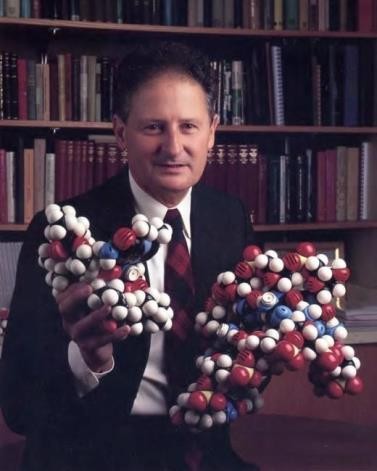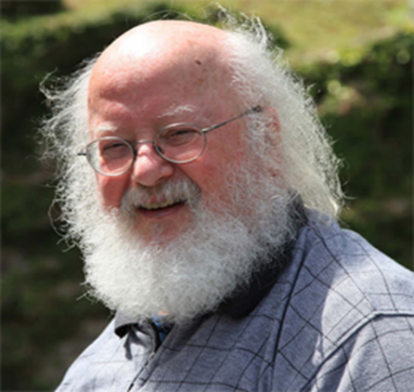Theme: An Insight into Every Dimension of Advanced Structural Biology Research
Structural Biology 2020
On behalf of Scientific Organising Committee we are overwhelmed to welcome all the interested participants to attend 19th International Conference on Structural Biology Webinar Event during September 28-29, 2020 .
The conference will be organized around the theme: An Insight into Every Dimension of Advanced Structural Biology Research
This Biochemistry Congress is going to be the largest and most promising international conference that specifically focuses on the Structural Biology by bringing all renowned researchers under one roof. This is a three day multidisciplinary meeting covering all aspects of novel research and contributions in the field of structural biology and biophysics.
- Commendable talks by the first-string of the global scientific community.
- Sterling workshop sessions.
- Remarkable Awards and Global Recognition to meritorious Researchers.
- Global Networking with 50+ Countries.
- Novel Techniques to Benefit Your Research.
- Global Business and Networking Opportunities.
- Exquisite platform for exhibiting your by-products and International Sponsorship
Young Scientist Benefits
- Our conferences provide best Platform for your research through oral presentations.
- Share the ideas with both eminent researchers and mentors.
- Young Scientist Award reorganization certificate and memento to the winners
- Young Scientists will get appropriate and timely information by this Forum.
- Platform for collaboration among young researchers for better development
- Award should motivate participants to strive to realize their full potential which could in turn be beneficial to the field as whole.
Deadline for Registrations:
Speaker Registration €249
Delegate Registration €299
Track 1: Structural Biology
Structural Biology is the branch of biology which embarks the importance of biophysics and biochemistry in the molecular structure of biological macromolecules. It also provides information about the effect of structural alterations of macromolecules on their function. This process of determination of structures of proteins, nucleic acids may take years as the shape, size and assemblies of these molecules may be altering the function.
-
Biochemistry
-
Structural modifications in nucleic acids
-
Biological system
-
Alternations in Protein Structure
Recommended Conferences:
Structural Biology Webinars 2020 | Structural Biology Online Events | Structural Biology Online Webinar | Scientific Webinars on Structural Biology | Best Structural Biology Podcasts 2020 | Structural Biology Webcast | Structural Biology Online Conferences | Structural Biology 2020 Live Events | Structural Biology Conference 2020
Related Societies:
American Society for Cell Biology, American Society for Biochemistry and Molecular Biology, Association of South-Eastern Biologists, Federation of European Biochemical Societies, Royal Society of Biology, Society for Experimental Biology, International Society for Computational Biology, Society for Molecular Biology and Evolution, American Crystallographic Association, Belgian Society of Biochemistry and Molecular Biology, International Mass Spectrometry Foundation, International Union of Crystallography, European Society of Human Genetics, European Proteomics Association, European Molecular Biology Organization, African Society for Bioinformatics and Computational Biology, American Mass Spectrometry Society, Australasian Proteomics Society, Austrian Proteomics Society.
Track 2: Proteomics and Genomics
Proteomics is the newest and the most discussed topic in the field of Structural Biology. It deals with determining the structure and function of proteins- the building blocks of the human body. It found its importance after the introduction of the Human Genome Project. Almost every process that occurs in our cells – from the metabolization of simple sugar to the division of cells – is dependent on proteins for smooth operation.
Genomics is the study of structure, working, mapping and alteration of genomes. The entire arrangement of DNA- the information centre of our body is known as genomics. Proteomics and Genomics are interrelated. Proteomics involve the study of structural determination of the body whereas Genomics involve the study of genetic makeup of the body.
- Chemical & single cell proteomics
- Molecular and cellular proteomics
- Expression proteomics
- Quantitative proteomics
- Post-translational modifications & signal transduction
- Cancer Genomics
- Clinical Genomics
- Comparative Genomics
- Functional Genomics
Recommended Conferences:
Structural Biology Webinars 2020 | Structural Biology Online Events | Structural Biology Online Webinar | Scientific Webinars on Structural Biology | Best Structural Biology Podcasts 2020 | Structural Biology Webcast | Structural Biology Online Conferences | Structural Biology 2020 Live Events | Structural Biology Conference 2020
Related Societies:
American Society for Cell Biology, American Society for Biochemistry and Molecular Biology, Association of South-Eastern Biologists, Federation of European Biochemical Societies, Royal Society of Biology, Society for Experimental Biology, International Society for Computational Biology, Society for Molecular Biology and Evolution, American Crystallographic Association, Belgian Society of Biochemistry and Molecular Biology, International Mass Spectrometry Foundation, International Union of Crystallography, European Society of Human Genetics, European Proteomics Association, European Molecular Biology Organization, African Society for Bioinformatics and Computational Biology, American Mass Spectrometry Society, Australasian Proteomics Society, Austrian Proteomics Society.
Track 3: Biochemistry and Biophysics
Biochemistry is the study of chemical processes taking place inside the human body. Recently this subject has found its importance in the biological world as it has found its importance in all fields of life science and biology. By controlling information flow through biochemical signalling and the flow of chemical energy through metabolism, biochemical processes give rise to the complexity of life. Its main focus is to understand how biological molecules give rise to the processes that occur within living cells.
Biophysics is the trending topic in the field of biology. It relates physics and biology. In other words, it signifies how traditional physical methods are used to study the biological phenomena inside the human body. Biophysical research shares significant overlap with biochemistry, molecular biology, physical chemistry, physiology, nanotechnology, bioengineering, computational biology, biomechanics and systems biology.
- Systems Biology
- Metabolomics
- Biomolecules
- Biophysical approaches to cell biology
- Membrane Biophysics
- Computational and theoretical Biophysics
- Computational and theoretical Biophysics
Recommended Conferences:
Structural Biology Webinars 2020 | Structural Biology Online Events | Structural Biology Online Webinar | Scientific Webinars on Structural Biology | Best Structural Biology Podcasts 2020 | Structural Biology Webcast | Structural Biology Online Conferences | Structural Biology 2020 Live Events | Structural Biology Conference 2020
Related Societies:
American Society for Cell Biology, American Society for Biochemistry and Molecular Biology, Association of South-Eastern Biologists, Federation of European Biochemical Societies, Royal Society of Biology, Society for Experimental Biology, International Society for Computational Biology, Society for Molecular Biology and Evolution, American Crystallographic Association, Belgian Society of Biochemistry and Molecular Biology, International Mass Spectrometry Foundation, International Union of Crystallography, European Society of Human Genetics, European Proteomics Association, European Molecular Biology Organization, African Society for Bioinformatics and Computational Biology, American Mass Spectrometry Society, Australasian Proteomics Society, Austrian Proteomics Society.
Track 4: Molecular Biology
Molecular Biology is a vast topic which deals with the structure and function of macromolecules. It is usually combined with techniques of Genetics and Biochemistry. Till 2000, Molecular genetics was the sub-field of Molecular Biology. Since Molecular Biology is mostly quantitative it’s in edge with computational biology and bioinformatics. Other zones of Biology focus directly or indirectly on molecules, whereas developmental biology and cell biology focus directly, while phylogenetic and evolutionary biology focus indirectly. Genetics deals with study of mutants and its comparison with the wild type (normal phenotype).
-
Genetics
-
Cell Biology
-
Developmental Biology
-
Gene Expression
Recommended Conferences:
Structural Biology Webinars 2020 | Structural Biology Online Events | Structural Biology Online Webinar | Scientific Webinars on Structural Biology | Best Structural Biology Podcasts 2020 | Structural Biology Webcast | Structural Biology Online Conferences | Structural Biology 2020 Live Events | Structural Biology Conference 2020
Related Societies:
American Society for Cell Biology, American Society for Biochemistry and Molecular Biology, Association of South-Eastern Biologists, Federation of European Biochemical Societies, Royal Society of Biology, Society for Experimental Biology, International Society for Computational Biology, Society for Molecular Biology and Evolution, American Crystallographic Association, Belgian Society of Biochemistry and Molecular Biology, International Mass Spectrometry Foundation, International Union of Crystallography, European Society of Human Genetics, European Proteomics Association, European Molecular Biology Organization, African Society for Bioinformatics and Computational Biology, American Mass Spectrometry Society, Australasian Proteomics Society, Austrian Proteomics Society.
Track 5: 3-D Structure Determination
Biomolecules are very small to see in detail even by most cutting-edge light microscopes. The methods that the structural biologists use to determine their structures in general involve the measurements on huge numbers of identical molecules at the same time. Some of the best methods include X-ray crystallography, cryo-electron microscopy and nuclear magnetic resonance. Apart from these methods there are many additional methods through which 3 D Structure Determination can be done.
-
X-ray crystallography
-
Nuclear Magnetic Resonances
-
Cryo-Electron Microscopy
-
Mass spectroscopy
-
Dual polarisation interferometry
-
Multi-angle light scattering Technique
-
Ultra-fast laser spectroscopy
Recommended Conferences:
Structural Biology Webinars 2020 | Structural Biology Online Events | Structural Biology Online Webinar | Scientific Webinars on Structural Biology | Best Structural Biology Podcasts 2020 | Structural Biology Webcast | Structural Biology Online Conferences | Structural Biology 2020 Live Events | Structural Biology Conference 2020
Related Societies:
American Society for Cell Biology, American Society for Biochemistry and Molecular Biology, Association of South-Eastern Biologists, Federation of European Biochemical Societies, Royal Society of Biology, Society for Experimental Biology, International Society for Computational Biology, Society for Molecular Biology and Evolution, American Crystallographic Association, Belgian Society of Biochemistry and Molecular Biology, International Mass Spectrometry Foundation, International Union of Crystallography, European Society of Human Genetics, European Proteomics Association, European Molecular Biology Organization, African Society for Bioinformatics and Computational Biology, American Mass Spectrometry Society, Australasian Proteomics Society, Austrian Proteomics Society.
Track 6: Computational Approach in Structural Biology
Computational approaches are a boon for structural biology. These methods use the concepts of bioinformatics to determine the structure of macromolecules. In general, the structure of molecules is determined by experimental methods is both time intense and cost effective. To overcome these constraints, computational approaches like ab-initio modelling, homology modelling and threading method are used.
-
Homology modelling
-
Ab-initio method
-
Threading
-
Discoveries through computational approaches
Recommended Conferences:
Structural Biology Webinars 2020 | Structural Biology Online Events | Structural Biology Online Webinar | Scientific Webinars on Structural Biology | Best Structural Biology Podcasts 2020 | Structural Biology Webcast | Structural Biology Online Conferences | Structural Biology 2020 Live Events | Structural Biology Conference 2020
Related Societies:
American Society for Cell Biology, American Society for Biochemistry and Molecular Biology, Association of South-Eastern Biologists, Federation of European Biochemical Societies, Royal Society of Biology, Society for Experimental Biology, International Society for Computational Biology, Society for Molecular Biology and Evolution, American Crystallographic Association, Belgian Society of Biochemistry and Molecular Biology, International Mass Spectrometry Foundation, International Union of Crystallography, European Society of Human Genetics, European Proteomics Association, European Molecular Biology Organization, African Society for Bioinformatics and Computational Biology, American Mass Spectrometry Society, Australasian Proteomics Society, Austrian Proteomics Society.
Track 7: Molecular Modelling and Dynamics
Molecular modelling involves the hypothetical and computational procedures which are used to mimic the behaviour of macromolecules. Molecular modelling techniques are used in various fields some of which are drug design, computational chemistry, materials science and computational biology. These methods are used for studying and understanding the properties of the molecules. One of the major applications of molecular modelling is molecular simulation. This is the technique which uses powerful lculatiocomputers to simulate the interactions between atoms and to understand the properties of materials. Such simulations involve methods that range from very detailed quantum mechanical cans on atoms to coarse-grained classical dynamics of large groups of molecules on a timescale of milliseconds or longer.
Molecular dynamics (MD) deals with the study of physical movements of the atoms and molecules using computer simulation method, so it is referred to as one of the type of N-body simulation. The atoms and molecules are allowed to interact for a fixed period of time, giving a view of the dynamic evolution of the system. The trajectories of atoms and molecules are commonly determined by solving them numerically using Newton’s equations of motion for a group of collaborating particles. The forces between the particles and their potential energies are calculated using inter-atomic potentials or molecular mechanics force fields.
-
Steered molecular dynamics (SMD)
-
Potentials in ab-initio methods
-
Hybrid QM/MM
-
Protein folding
-
Enzyme catalysis
-
Protein stability
-
Molecular recognition of proteins
-
DNA and membrane complexes
Recommended Conferences:
Structural Biology Conferences | Structural Biology Events | Biochemistry Conferences | Biochemistry Congress | Biochemistry Meetings | Nano patterning methods | Structural Biology 2018 | Computer-aided Drug Design | Enzymology Conferences | Molecular modelling | Cell signalling pathways | Hybrid QM/MM Techniques
Related Societies:
American Society for Cell Biology, American Society for Biochemistry and Molecular Biology, Association of South-Eastern Biologists, Federation of European Biochemical Societies, Royal Society of Biology, Society for Experimental Biology, International Society for Computational Biology, Society for Molecular Biology and Evolution, American Crystallographic Association, Belgian Society of Biochemistry and Molecular Biology, International Mass Spectrometry Foundation, International Union of Crystallography, European Society of Human Genetics, European Proteomics Association, European Molecular Biology Organization, African Society for Bioinformatics and Computational Biology, American Mass Spectrometry Society, Australasian Proteomics Society, Austrian Proteomics Society.
Track 8: Drug Designing and Biomarkers
A biomarker is an attribute that can be studied as an indicator of pathogenic and biological operation along with pharmacological retort to a therapeutic involvement. They indicate either normal or diseased activity in the body. Biomarkers are specific molecules, genes, gene products, hormones, cells or enzymes.
-
Drug designing is an inventive process to find new medication centred on the knowledge of biological target. Drug is most commonly a small molecule that inhibits or activates the function of a biomolecule, which in turn outcomes in a therapeutic benefit to the patient. Drug design commonly but not essentially relies on computational techniques. This type of modelling is often mentioned to as computer-aided drug design.
Drug targets -
Ligand-based design
-
Structure-based design
-
Computer-aided drug design
-
Scoring functions
Recommended Conferences:
Structural Biology Webinars 2020 | Structural Biology Online Events | Structural Biology Online Webinar | Scientific Webinars on Structural Biology | Best Structural Biology Podcasts 2020 | Structural Biology Webcast | Structural Biology Online Conferences | Structural Biology 2020 Live Events | Structural Biology Conference 2020
Related Societies:
American Society for Cell Biology, American Society for Biochemistry and Molecular Biology, Association of South-Eastern Biologists, Federation of European Biochemical Societies, Royal Society of Biology, Society for Experimental Biology, International Society for Computational Biology, Society for Molecular Biology and Evolution, American Crystallographic Association, Belgian Society of Biochemistry and Molecular Biology, International Mass Spectrometry Foundation, International Union of Crystallography, European Society of Human Genetics, European Proteomics Association, European Molecular Biology Organization, African Society for Bioinformatics and Computational Biology, American Mass Spectrometry Society, Australasian Proteomics Society, Austrian Proteomics Society.
Track 9: Gene regulation and Cell Signalling
Signalling is the process through which the cells communicate with each other. They are often secreted from the cell and released into the extracellular space. Regulation of gene expression comprises a comprehensive range of mechanisms that are used by cells to regulate the production of specific gene products, and is familiarly termed as gene regulation. Sophisticated programs of gene expression are extensively observed in biology, for example to trigger developmental pathways, adapt to new food sources, or respond to environmental stimuli.
-
G-protein-coupled receptor
-
Adrenergic receptor
-
Protein crystallography
-
Protein structure
Recommended Conferences:
Structural Biology Webinars 2020 | Structural Biology Online Events | Structural Biology Online Webinar | Scientific Webinars on Structural Biology | Best Structural Biology Podcasts 2020 | Structural Biology Webcast | Structural Biology Online Conferences | Structural Biology 2020 Live Events | Structural Biology Conference 2020
Related Societies:
American Society for Cell Biology, American Society for Biochemistry and Molecular Biology, Association of South-Eastern Biologists, Federation of European Biochemical Societies, Royal Society of Biology, Society for Experimental Biology, International Society for Computational Biology, Society for Molecular Biology and Evolution, American Crystallographic Association, Belgian Society of Biochemistry and Molecular Biology, International Mass Spectrometry Foundation, International Union of Crystallography, European Society of Human Genetics, European Proteomics Association, European Molecular Biology Organization, African Society for Bioinformatics and Computational Biology, American Mass Spectrometry Society, Australasian Proteomics Society, Austrian Proteomics Society.
Tracks 10: Structural Enzymology
Enzymes play a crucial role in signalling the cellular and metabolic pathways. Research works are going on to identify, how the enzymes function at molecular and atomic level by combining the modern and structural biology.
-
Protein engineering
-
Protein prenylation techniques
-
Steady state kinetics
-
Calorimetric methods
-
Chemical analysis
Recommended Conferences:
Structural Biology Webinars 2020 | Structural Biology Online Events | Structural Biology Online Webinar | Scientific Webinars on Structural Biology | Best Structural Biology Podcasts 2020 | Structural Biology Webcast | Structural Biology Online Conferences | Structural Biology 2020 Live Events | Structural Biology Conference 2020
Related Societies:
American Society for Cell Biology, American Society for Biochemistry and Molecular Biology, Association of South-Eastern Biologists, Federation of European Biochemical Societies, Royal Society of Biology, Society for Experimental Biology, International Society for Computational Biology, Society for Molecular Biology and Evolution, American Crystallographic Association, Belgian Society of Biochemistry and Molecular Biology, International Mass Spectrometry Foundation, International Union of Crystallography, European Society of Human Genetics, European Proteomics Association, European Molecular Biology Organization, African Society for Bioinformatics and Computational Biology, American Mass Spectrometry Society, Australasian Proteomics Society, Austrian Proteomics Society.
Track 11: Sequencing Analysis
Sequence analysis can be explained as a process of exposing DNA, RNA or peptide sequence to a wide range of analytical methods in order to understand its structure, function and evolution. The methods include sequence alignment and biological databases. Synergistic use of three-dimensional structures and deep sequencing is done to realize the effect of personalized medicine. The usage of sequence analysis in structural biology will pave the way to new methods which can be utilized to determine the structure of molecules.
-
Profile comparison
-
Sequence assembly
-
Gene prediction
-
Deep sequencing for protein structure determination
-
Complementary Methods
-
Deep sequencing for cancer studies
-
Deep sequencing of HIV
Recommended Conferences:
Structural Biology Webinars 2020 | Structural Biology Online Events | Structural Biology Online Webinar | Scientific Webinars on Structural Biology | Best Structural Biology Podcasts 2020 | Structural Biology Webcast | Structural Biology Online Conferences | Structural Biology 2020 Live Events | Structural Biology Conference 2020
Related Societies:
American Society for Cell Biology, American Society for Biochemistry and Molecular Biology, Association of South-Eastern Biologists, Federation of European Biochemical Societies, Royal Society of Biology, Society for Experimental Biology, International Society for Computational Biology, Society for Molecular Biology and Evolution, American Crystallographic Association, Belgian Society of Biochemistry and Molecular Biology, International Mass Spectrometry Foundation, International Union of Crystallography, European Society of Human Genetics, European Proteomics Association, European Molecular Biology Organization, African Society for Bioinformatics and Computational Biology, American Mass Spectrometry Society, Australasian Proteomics Society, Austrian Proteomics Society.
Track 12: Hybrid approaches in Structure prediction
This is a cost effective approach for determining the protein structure. The computational prediction methods, such as initiating fragment assembly, advanced fold recognition, composite approaches, and molecular docking are regularly applied in recent times to expand our understanding of protein structures. Hybrid approach is a channel to overcome these disadvantages, by incorporating limited experimental measurements, reliable structures can be computed, and unlikely predictions are eliminated. The current researches are showing great interest in this method of approach.
-
NMR structures
-
Hybrid of experimental methods
-
Hybrid of computational methods
-
Hybrid approaches in complementing high-resolution structural biology
-
Determining protein complex structures
-
Bottom-up integration of atomic detail crystallography
Recommended Conferences:
Structural Biology Webinars 2020 | Structural Biology Online Events | Structural Biology Online Webinar | Scientific Webinars on Structural Biology | Best Structural Biology Podcasts 2020 | Structural Biology Webcast | Structural Biology Online Conferences | Structural Biology 2020 Live Events | Structural Biology Conference 2020
Related Societies:
American Society for Cell Biology, American Society for Biochemistry and Molecular Biology, Association of South-Eastern Biologists, Federation of European Biochemical Societies, Royal Society of Biology, Society for Experimental Biology, International Society for Computational Biology, Society for Molecular Biology and Evolution, American Crystallographic Association, Belgian Society of Biochemistry and Molecular Biology, International Mass Spectrometry Foundation, International Union of Crystallography, European Society of Human Genetics, European Proteomics Association, European Molecular Biology Organization, African Society for Bioinformatics and Computational Biology, American Mass Spectrometry Society, Australasian Proteomics Society, Austrian Proteomics Society.
Track 13: Structural Bioinformatics
Structural bioinformatics is an exceptionally cost-effective solution for protein structure determination. Purely computational prediction methods, like ab initio fragment assembly, advanced fold recognition, composite approaches, and molecular docking are regularly applied today to extend our understanding of protein structures. However, predicted structures are not given the same reliance as their experimental complements. Hybrid approaches are a means to overcome these limitations; by incorporating limited experimental measurements, reliable structures can be computed, and unlikely predictions eliminated. Hybrid approaches take advantage of data derived from a wide range of different biophysical and biochemical methods. These methods are of growing interest in current researches of structural biology.
-
Genome Mapping
-
Translational Medicine
-
Protein Modelling
-
Epigenomic data analysis
-
Computational Neuroscience
-
Mathematical Techniques
Recommended Conferences:
Structural Biology Webinars 2020 | Structural Biology Online Events | Structural Biology Online Webinar | Scientific Webinars on Structural Biology | Best Structural Biology Podcasts 2020 | Structural Biology Webcast | Structural Biology Online Conferences | Structural Biology 2020 Live Events | Structural Biology Conference 2020
Related Societies:
American Society for Cell Biology, American Society for Biochemistry and Molecular Biology, Association of South-Eastern Biologists, Federation of European Biochemical Societies, Royal Society of Biology, Society for Experimental Biology, International Society for Computational Biology, Society for Molecular Biology and Evolution, American Crystallographic Association, Belgian Society of Biochemistry and Molecular Biology, International Mass Spectrometry Foundation, International Union of Crystallography, European Society of Human Genetics, European Proteomics Association, European Molecular Biology Organization, African Society for Bioinformatics and Computational Biology, American Mass Spectrometry Society, Australasian Proteomics Society, Austrian Proteomics Society.
Track 14: Frontiers in Structural Biology
The main focus of a structural biologist is protein structure determination and drug design. Protein plays an important role in human body. Living things would not exist without proteins. The proteins are usually involved in all forms of expressions of the living organism. Most of the proteins are evolved in providing structure to the cell while the others tend to bin and carry vital molecules all through the body. Some proteins are involved in biochemical reactions in the body which are termed as enzymes. Others are involved in muscle contractions and immunity. Structure determination of proteins has always been a challenging filed. The complex areas in the field include viruses, pathogens, membrane proteins and signalling pathways. Novel progressions are being done in the arenas of nano-patterning and multi-scale modelling of cell signalling proteins.
-
Membrane proteins
-
Pathogens and viruses
-
Nano patterning
-
Macromolecular designing
Recommended Conferences:
Structural Biology Webinars 2020 | Structural Biology Online Events | Structural Biology Online Webinar | Scientific Webinars on Structural Biology | Best Structural Biology Podcasts 2020 | Structural Biology Webcast | Structural Biology Online Conferences | Structural Biology 2020 Live Events | Structural Biology Conference 2020
Related Societies:
American Society for Cell Biology, American Society for Biochemistry and Molecular Biology, Association of South-Eastern Biologists, Federation of European Biochemical Societies, Royal Society of Biology, Society for Experimental Biology, International Society for Computational Biology, Society for Molecular Biology and Evolution, American Crystallographic Association, Belgian Society of Biochemistry and Molecular Biology, International Mass Spectrometry Foundation, International Union of Crystallography, European Society of Human Genetics, European Proteomics Association, European Molecular Biology Organization, African Society for Bioinformatics and Computational Biology, American Mass Spectrometry Society, Australasian Proteomics Society, Austrian Proteomics Society.
Track 15: Structural Biology in Cancer Research
The main aim of integrating structural biology data into cancer research is to design and discover novel and effective drugs to cure the disease. Structural biology combined with molecular modelling mainly aims at drug designing. Consequently, a number of Structural Biologists are conducting cancer research, to speed-up the process of understanding the mechanism of biomolecules in order to improve the newer cancer therapies.
Major part of research is being carried out in the area of cancer. The main aim is to design and discover novel and effective drugs to cure the disease. Structural biology combined with molecular modelling mainly aims at drug designing. Subsequently, numerous team leaders in Structural biology carry out cancer research to accelerate the exploitation of molecular understanding of biomolecules in the advancement of novel cancer therapies.
-
Cancer Systems Biology
-
Tumorigenesis
-
Cancer Heterogeneity
-
Epidemiology
-
Statistical and Mechanistic Modelling of Signalling Networks
Recommended Conferences:
Structural Biology Webinars 2020 | Structural Biology Online Events | Structural Biology Online Webinar | Scientific Webinars on Structural Biology | Best Structural Biology Podcasts 2020 | Structural Biology Webcast | Structural Biology Online Conferences | Structural Biology 2020 Live Events | Structural Biology Conference 2020
Related Societies:
American Society for Cell Biology, American Society for Biochemistry and Molecular Biology, Association of South-Eastern Biologists, Federation of European Biochemical Societies, Royal Society of Biology, Society for Experimental Biology, International Society for Computational Biology, Society for Molecular Biology and Evolution, American Crystallographic Association, Belgian Society of Biochemistry and Molecular Biology, International Mass Spectrometry Foundation, International Union of Crystallography, European Society of Human Genetics, European Proteomics Association, European Molecular Biology Organization, African Society for Bioinformatics and Computational Biology, American Mass Spectrometry Society, Australasian Proteomics Society, Austrian Proteomics Society.
Track 16: Molecular biology techniques
Molecular techniques are used in molecular biology, biochemistry and genetics for the analysis of DNA, RNA and protein. Molecular cloning is the widely used molecular technique. The different methods in molecular biology are Haemocytometer cell counter, Restriction enzyme digestion, DNA ligation, transfection, western blot, plasmid purification, electroporation, heat shock method and ELISA.
-
DNA sequencing
-
Gene delivery
-
Microarrays
Recommended Conferences:
Structural Biology Webinars 2020 | Structural Biology Online Events | Structural Biology Online Webinar | Scientific Webinars on Structural Biology | Best Structural Biology Podcasts 2020 | Structural Biology Webcast | Structural Biology Online Conferences | Structural Biology 2020 Live Events | Structural Biology Conference 2020
Related Societies:
American Society for Cell Biology, American Society for Biochemistry and Molecular Biology, Association of South-Eastern Biologists, Federation of European Biochemical Societies, Royal Society of Biology, Society for Experimental Biology, International Society for Computational Biology, Society for Molecular Biology and Evolution, American Crystallographic Association, Belgian Society of Biochemistry and Molecular Biology, International Mass Spectrometry Foundation, International Union of Crystallography, European Society of Human Genetics, European Proteomics Association, European Molecular Biology Organization, African Society for Bioinformatics and Computational Biology, American Mass Spectrometry Society, Australasian Proteomics Society, Austrian Proteomics Society.
Track 17: Structural Biology Databases
A database is an organised collection of data. As a result of enormous research which is being done in Structural biology massive data has been produced. In order to assemble the data in a catalogued manner, bioinformatics databases are used. Various databases have been created to store biological data, such as sequence databases, structure databases, signalling pathway databases, etc.
A database is a structured collection of data. In the field of structural biology enormous research is being done and as a result massive data is being produced. In order to pile the data in an organized manner, bioinformatics databases are used. Various databases have been created to store biological data, such as sequence databases, structure databases, signalling pathway databases, etc. In the field of structural biology, the mainly used databases are Protein Data Bank (PDB), Electron Microscopy Data Bank, Protein Structure Classification Database (CATH) and Structural Classification of Protein (SCOP).
-
Classification of structural database
-
Classification of protein structure
-
Protein structure classification database
-
Protein data bank
-
Electron microscopy data bank
Recommended Conferences:
Structural Biology Webinars 2020 | Structural Biology Online Events | Structural Biology Online Webinar | Scientific Webinars on Structural Biology | Best Structural Biology Podcasts 2020 | Structural Biology Webcast | Structural Biology Online Conferences | Structural Biology 2020 Live Events | Structural Biology Conference 2020
Related Societies:
American Society for Cell Biology, American Society for Biochemistry and Molecular Biology, Association of South-Eastern Biologists, Federation of European Biochemical Societies, Royal Society of Biology, Society for Experimental Biology, International Society for Computational Biology, Society for Molecular Biology and Evolution, American Crystallographic Association, Belgian Society of Biochemistry and Molecular Biology, International Mass Spectrometry Foundation, International Union of Crystallography, European Society of Human Genetics, European Proteomics Association, European Molecular Biology Organization, African Society for Bioinformatics and Computational Biology, American Mass Spectrometry Society, Australasian Proteomics Society, Austrian Proteomics Society.
Track 18: Advancements in structural Biology
Structural biology is one of the progressing fields. In the course of time many developments have been taking place. Huge numbers of solved structures have exaggerated rapidly. The field of drug design and drug discovery has been advanced. Functional annotations are another field where progressions are rapidly evolving. Alterations in order to improve the effectiveness of prevailing tools can also be noted. Remarkable advances have been made in the areas of technical imaging and advancement of hybrid methods to understand the structure and function of proteins.
-
Advances in Drug Design
-
Advances in Tool Development
-
Advances in Imaging Technologies
Recommended Conferences:
Structural Biology Webinars 2020 | Structural Biology Online Events | Structural Biology Online Webinar | Scientific Webinars on Structural Biology | Best Structural Biology Podcasts 2020 | Structural Biology Webcast | Structural Biology Online Conferences | Structural Biology 2020 Live Events | Structural Biology Conference 2020
Related Societies:
American Society for Cell Biology, American Society for Biochemistry and Molecular Biology, Association of South-Eastern Biologists, Federation of European Biochemical Societies, Royal Society of Biology, Society for Experimental Biology, International Society for Computational Biology, Society for Molecular Biology and Evolution, American Crystallographic Association, Belgian Society of Biochemistry and Molecular Biology, International Mass Spectrometry Foundation, International Union of Crystallography, European Society of Human Genetics, European Proteomics Association, European Molecular Biology Organization, African Society for Bioinformatics and Computational Biology, American Mass Spectrometry Society, Australasian Proteomics Society, Austrian Proteomics Society.
Assets apportioned to Structural Biology Research:
The Higher Education Funding Council for European nation (HEFCE), the office responsible for the circulation of practically £8 billion (US$11.3 billion) of administration assets for the instructive year 2009–10, divulged conditional subsidizing distributions for investigation (£1.57 billion) and instructing (£4.78 billion). Office spends or so $65 million consistently for super atom structure assurance. Australia awards cost $7.4 million for fourteen national comes supporting the development of the therapeutic innovations, biotechnologies and endorsed drugs division. The Ministry of Education, Culture, Sports, Science and Technology (MEXT)— the main authority body in organizing and subsidizing science and innovation activities in Japan—mentioned US$11.1 billion for science and innovation installment in its anticipated spending plan. National Institute on propensity (NIDA), bar investigation, has supported $358.1 million of every 2015. The territory of American state has purportedly put with $10-12 million in direct disease examination every year, while the National Cancer Institute (NCI) among the U. S. has supposedly pay $4.8 to $5.2 billion every year on malignant growth examination and treatment advancement. With the ongoing solicitation for applications, the NIGMS hopes to help 3 to 6 monstrous investigation focus' at evaluation of up to $3 million for every middle
Market Value of Structural Biology:
The principle examination promote is depended upon to accomplish USD 41.34 Billion by 2021 from USD 28.66 Billion out of 2016, at a CAGR of 7.6% from 2016 to 2021. The principle contemplations driving the improvement of this market are the creating biotechnology and biopharmaceutical adventures, introduction of creatively moved cell examination instruments, extending event of powerful and endless sicknesses and rising number of patients encountering ailment, and growing theories from various government affiliations and life sciences associations for cell science inspect works out.
The market is basically controlled by the growing exploration financing for helper science from governments and private theorists, creating enthusiasm for novel drug diagram and tweaked arrangement in the U.S. in addition, Europe, and the growing necessity for toxicology testing. The closeness of endless equipment makers has contributed on a very basic level toward the North American and European assistant science/sedate publicizes. In any case, the Asia-Pacific district addresses a vital improvement open entryway for the helper science/quiet market during the check time of 2014 to 2019. The APAC grandstand is depended upon to create at a CAGR of 23% during the measure time allotment. The improvement in this market is driven by the creating pharmaceutical and biotechnology adventures. The overall essential science promotes was regarded at $565 million out of 2014 and is depended upon to create at a CAGR of 30% from 2014 to 2019.
Target audience:
Directors/Managers & Business Delegates, Director of Laboratories, Universities, Industries, Investigators, Post-Doctoral Fellows, Research and Diagnostic Laboratories, Clinical Fellows, Research Scholars, Students, Biomedical Research companies.
Rise in the number of clinical trials, toxicological studies, and health awareness for nutritional products, rapid growth of structural biology analytical instruments, software and solutions, implementing the methods of Structural Biology will help in the growth and development of the pharmaceutical company.

Major Structural Biology Related Associations around the Globe:
Biophysical Society
American Society for Biochemistry and Molecular Biology
Czech Society for Structural Biology
American Chemical Society
New England Structural Biology Association
The Protein Society
American Crystallographic Association
International Union of Crystallography
British Crystallographic Association
European Crystallographic Association
Hellenic Crystallographic Association
Bioinformatics society of India
International Society for Computational Biology
South African Crystallographic Society
Why to attend?
Those who want to meet the market targets by introducing the recent business reports in structural biology and also drug designing, which manifests the increased growth in pharmaceutical industry. As Structural Biology is focussed on determination of the structure based on methods such as X-ray crystallography, Computational approaches for structure prediction, NMR studies, drug designing. The companies dealing with analytical instruments and software will have a great opportunity in these fields. Also many upcoming students and researchers can benefit themselves by participating in world class International workshops, symposia during the conference which will be conducted by experts in the respective fields.
Conference Highlights
- Structural Biology
- Proteomics and Genomics
- Biochemistry and Biophysics
- Molecular Biology
- 3-D Structure Determination
- Computational Approach in Structural Biology
- Molecular Modelling and Dynamics
- Drug Designing and Biomarkers
- Gene regulation and Cell Signalling
- Structural Enzymology
- Sequencing Analysis
- Hybrid approaches in Structure prediction
- Structural Bioinformatics
- Frontiers in Structural Biology
- Structural Biology in Cancer Research
- Molecular biology techniques
- Structural Biology Databases
- Advancements in structural Biology
To share your views and research, please click here to register for the Conference.
To Collaborate Scientific Professionals around the World
| Conference Date | September 28-29, 2020 | ||
| Sponsors & Exhibitors |
|
||
| Speaker Opportunity Closed | |||
| Poster Opportunity Closed | Click Here to View | ||
Useful Links
Special Issues
All accepted abstracts will be published in respective Our International Journals.
- Journal of Proteomics & Bioinformatics
- Structural Chemistry & Crystallography Communication
- Cellular and Molecular Biology
Abstracts will be provided with Digital Object Identifier by






















